IAC News
IAC News No.117, July 2022
Japan Society of Civil Engineers International Activities Center July 1, 2022 IAC News No.117
Message to Mark Inauguration as JSCE President
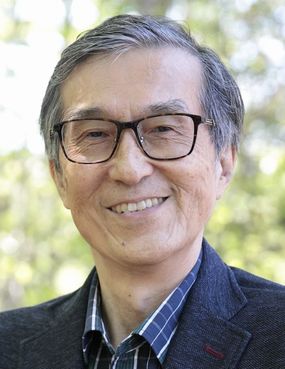 Tamon Ueda
Tamon Ueda
110th JSCE President
*Photographer: Rumiko Ito
I was appointed as the 110th president of JSCE at the General Meeting held on June 10. JSCE has a long history, and I feel a great sense of responsibility in being appointed this role. Amidst this once-in-a-century set of circumstances with the coronavirus pandemic and the situation in Ukraine, I have been put in charge of steering the future of JSCE. Civil engineering must play a part in solving such global issues. In this sense, JSCE must also pay close attention to what is happening around the world.
JSCE is unique. Why? Because domestically it has not split and become independent from The Japan Federation of Engineering Societies but continued to assist the Federation, and internationally because it is one of the few organizations where engineers from industry, government, and academia come together to undertake engineering activities. Accordingly, JSCE was founded more recently than compared to other societies, and it can be said that organizations like JSCE do not typically exist in other countries, or even if such an organization does exist, its activities do not carry much weight. That is, JSCE is, globally speaking, a rare organization that can deal with various issues in the all-encompassing field of civil engineering. I hope that all the members of the society will take advantage of this feature to use JSCE to contribute where possible as a civil engineer or a civil engineering stakeholder to help resolve domestic and international issues.
The current civil engineering situation in Japan is by no means positive. The construction market has been shrinking over the long term, and civil engineering as a research field is considered to be not as essential as other fields. In fact, the reason for this is thought to be that the civil engineering capacity of Japan is inferior to that of major overseas countries. Under the 108th president, Hitoshi Ieda, JSCE conducted an “Infrastructure Report Card” initiative to clarify the reality of the situation, and under the 109th president, Hiroaki Taniguchi, JSCE highlighted a future vision for civil engineering with the “Big Picture of Civil Engineering.” As my project as president, I will focus on civil engineering human resources, and by having researchers and engineers understand what Japan is capable of and engaging in discussions with each other, I will build a platform to create a path to develop individuals who can solve global issues in the future. Furthermore, I will aim to create civil engineering projects that are accepted by other countries.
To finish, I would like to inform you about the initiating of a collaborative effort between the Architectural Institute of Japan and JSCE that was created in 2021 to realize the ultimate vision for the Japanese construction field in collaboration with the construction field, whose status is subsiding just like that of the civil engineering field. This collaboration is also important for tackling global issues.
During this year as president, I will do my best to ensure JSCE contributes further to society by looking at things from new perspectives. I ask for your understanding and cooperation, and I look forward to hearing what you think via the JSCE feedback page. (https://committees.jsce.or.jp/chair/).

Suez Canal Bridge Maintenance and Repair Project
Stretching over the Suez Canal, which sees some of the world’s largest vessels pass through its waters, the Suez Canal Bridge was completed in October 2001 as a project undertaken with grant aid from the Japanese government. Built in the desert across the Suez Canal, the Suez Canal Bridge has pylons standing about 140 meters tall (with a 70-meter clearance under the bridge), which is roughly the same height as the Great Pyramid of Giza, and is shaped like a magnificent ancient Egyptian-style cable-stayed bridge inspired by the Pharaonic obelisks (an ancient Egyptian monument). By connecting the mainland of Egypt and the Sinai Peninsula, the Suez Canal Bridge is an important route that contributes significantly to facilitating logistics and networking as well as regional development as a symbol connecting African and Asian.
In 2010, more than eight years after the bridge opened, damage was confirmed to some of the piers and part of the road surface, and after a follow-up survey by those involved on the Japanese side, work to repair the substructure, road surface, and steel deck plate was carried out from 2012 to 2016 as follow-up construction work involving the parties on both sides.
With regards to the substructure, the damage to the piers was particularly serious, and the peeling of the surface concrete and the corrosion of the reinforcing steel bars were so severe that they were of a level not witnessed in Japan. It came to light that the damage was caused by a large salt pan on the east side of the bridge and a large amount of condensation due to low temperatures at night. The repair work saw the removal of damaged parts and reinforcing steel bar rust, and the imperfections were filled with repair mortar before coating the surface.
As for the damage to the steel deck plate under the road surface, it was presumed that the main cause was the rusting of the steel deck plate caused by cracks in the road surface from the frequent passing of heavy military vehicles (loaded with rocks and estimated to weigh around 50-60 tons) over the bridge and subsequent water ingress due to the occurrence of condensation (a large build-up of water was confirmed in the drainage basin even during the dry months of the year). As a result of examining possible ways to repair this damage, a fine-grained asphalt road surface that has maintained its structural integrity for at least 10 years in other projects in Egypt was adopted.
The series of surveys and repair work on the Suez Canal Bridge made the engineers of the ministry of construction of Egypt (GARBLT: General Authority for Roads, Bridges and Land Transport) aware of the importance of maintenance, and instruction and construction management were conducted focusing on whether the repair work that may occur again in the future could be carried out by Egyptian engineers and contractors.
While everyone recognized the importance of bridge maintenance, this work made us aware of how difficult it is to propose an appropriate maintenance method that is suited to the specific circumstances in the said country and the technical capabilities of the organization that carries out maintenance. There is a tendency to impose Japan’s technological capabilities on developing countries, but the key is to cooperate from the perspective of training engineers in the respective country while adjusting to the specific circumstances in the country.
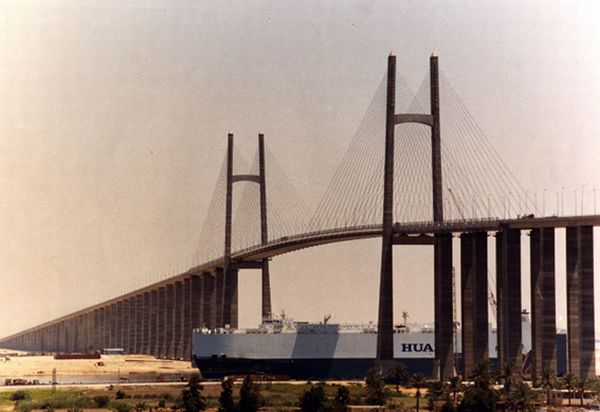
Suez Canal Bridge
Substructure Repair Work
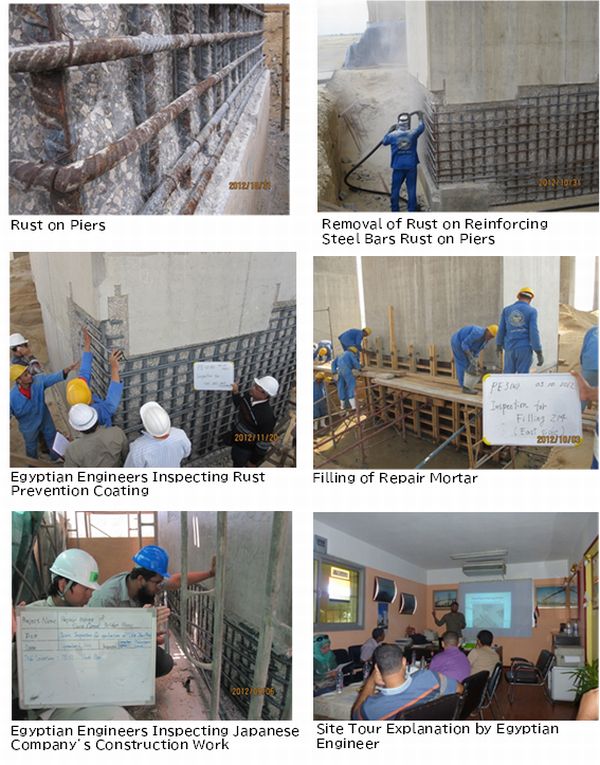
Road Surface & Steel Deck Plate Repair Work
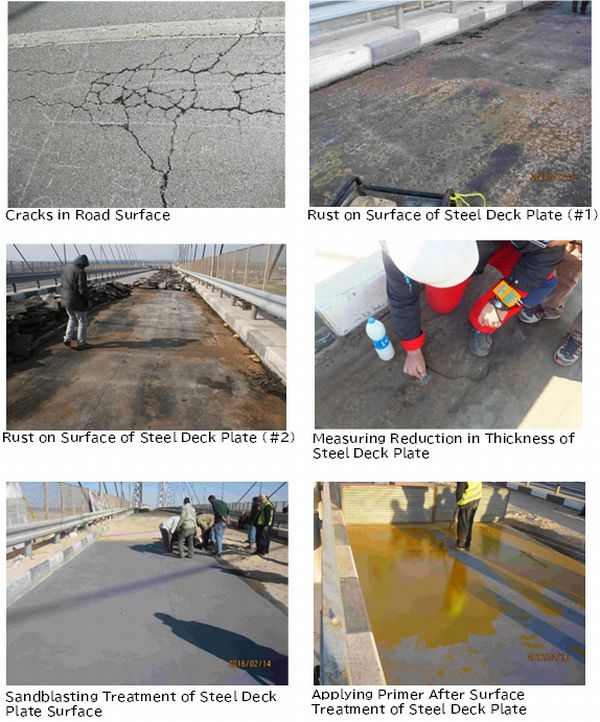
【Reported by Tatso Mukoyama (Oriental Consultants Global Co., Ltd.)】
FY2021 JSCE Awards
Twenty-eight civil engineers including six non-Japanese engineers were recognized with International Lifetime Contribution Award, Continuing International Contribution Award, and International Outstanding Collaboration Award on June 10, 2022. The recipients by award are listed in the table below.
For further details, please visit http://www.jsce-int.org/a_t/international .
< International Lifetime Contribution Award: 4 recipients >
The Award recognizes (1) Japanese civil engineers for their significant contributions to the development of civil engineering technology and/or the infrastructure development through their professional practices in and outside Japan; (2) non-Japanese civil engineer(s) for his/her commendable achievements to the progress and promotion of Japanese civil engineering.
| NAME | AFFILIATION |
| Naoki Kita | SHIMIZU CORPORATION |
| Yasushi Nakagawa | TEKKEN CORPORATION |
| Susumu Naruse | MIYAJI ENGINEERING GROUP, INC. |
| Kenzo Hiroki | The National Graduate Institute for Policy Studies |
< Continuing International Contribution Award: 17 recipients >
The Award recognizes young professionals who have made and will make a significant contribution to the development of civil engineering and/or the development of infrastructure outside Japan with their unique and inspiring perspectives and solid technical skills.
| NAME | AFFILIATION | NAME | AFFILIATION |
| Yoshihisa Asada | Oriental Consultants Global Co., Ltd. | Yuichi Takemura | SHIMIZU CORPORATION |
| Koichi Ota | The Kansai Electric Power Company, Incorporate | Koji Naito | CTI Engineering International Co., Ltd. |
| Gou Orukawa | Electric Power Development Co., Ltd. | Hideki Fukami | OBAYASHI CORPORATION |
| Osamu Kutami | Dai Nippon Construction | Futoshi Mitsuhata | EAST JAPAN RAILWAY COMPANY |
| Takumi Kodaki | TOBISHIMA CORPORATION | Hirotsugu Mori | Japan International Cooperation Agency |
| Kenichiro Kobayashi | Kyoto University | Mitsuhiro Yao | Ministry of Land, Infrastructure, Transport and Tourism |
| Yoshimoto Koyanagi | Japan International Cooperation Agency | Dai Yamashita | PENTA-OCEAN CONSTRUCTION CO., LTD |
| Shinji Sassa | The Port and Airport Research Institute | Kenji Yoshikawa | Kajima Overseas Asia (Singapore) |
| Masakazu Sota | TAISEI CORPORATION |
< International Outstanding Collaboration Award: 7 recipients >
The Award recognizes foreigners who have made contributions to the development of civil engineering in Japan or other countries, through the exchange and collaboration with Japan, and are expected to play an active role in the progress and development of civil engineering field.
| NAME | AFFILIATION |
| Masanori Teddy Kartasasmita | Nippon Koei Co., Ltd. |
| Nguyen Quoc Thai | Oriental Consultants Global Co., Ltd. |
| Nguyen Trung Viet | Thuyloi University |
| Jian-Guo Dai | The Hong Kong Polytechnic University |
| Noel Sun Aguas | TAISEI CORPORATION |
| Panganayi Cleopatra | Oriental Consultants Global Co., Ltd. |
| Jan Dirk Schmoecker | Kyoto University |
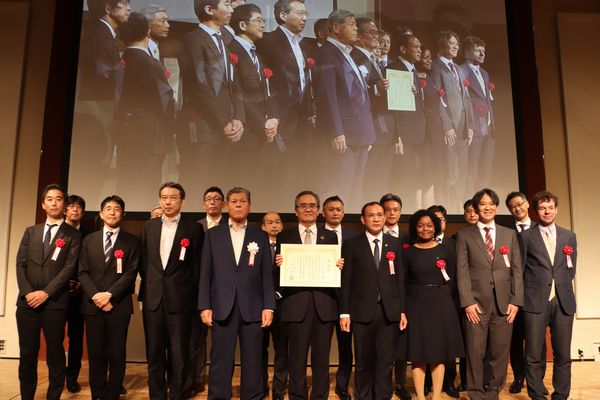 FY2021 JSCE Awards Ceremony
FY2021 JSCE Awards Ceremony
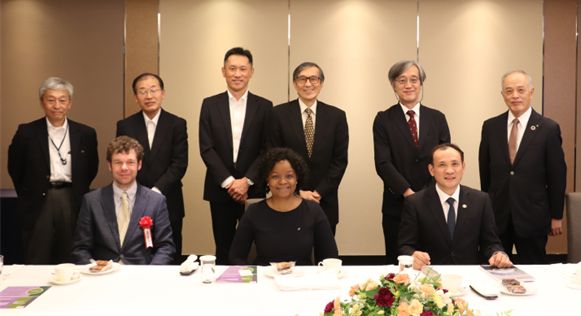
FY2021 JSCE Awards Celebration
Updates
◆The 10th Civil Engineer’s Lounge “DOBOKU” (Japanese): https://committees.jsce.or.jp/kokusai/node/284
◆JSCE-ASCE Infrastructure Resilience Research Group: https://www.infraresil.jp/
◆2022 JSCE Annual Meeting International Program (Japanese): https://committees.jsce.or.jp/kokusai/node/286
◆JSCE Concrete Committee Newsletter No.65, May 2022: https://www.jsce.or.jp/committee/concrete/e/newsletter/newsletter65/index.html
◆5th Japan Construction International Award: https://www.mlit.go.jp/JCIA/en/award/5/
◆The International Infrastructure Archives – A Compilation of Japan’s Greatest Projects in Transfer of Civil Engineering Technology in Service – http://www.jsce.or.jp/e/archive/
◆The 9th Civil Engineering Conference in the Asian Region (CECAR9): https://cecar9.com/
◆The 4th Asian Concrete Federation (ACF) Symposium on Emerging Technologies for Structural Longevity (ACF2022_ETSL):
https://acf2022.aconf.org/index.html
◆American Society of Civil Engineers(ASCE)
・ASCE Convention 2022
https://www.asce.org/education-and-events/events/meetings/asce-convention-2022/
◆The 9th International Conference on Flood Management (ICFM9): https://www.icfm9.jp/index.html
◆IAC “News Pick Up!!” on the JSCE Japanese website: https://committees.jsce.or.jp/kokusai/iac_dayori_2022
◆Summary of featured articles in JSCE Magazine Vol. 107, No.7 July 2022: http://www.jsce-int.org/pub/magazine
◆Journal of JSCE
https://www.jstage.jst.go.jp/browse/journalofjsce
Subcription
The IAC News is one of the communication tools to share information and ideas with the members. We would like to invite you, your friends and colleagues to join the communication and to subscribe the IAC News. Please register online: (http://www.jsce-int.org/node/150). We look forward to meeting you.
